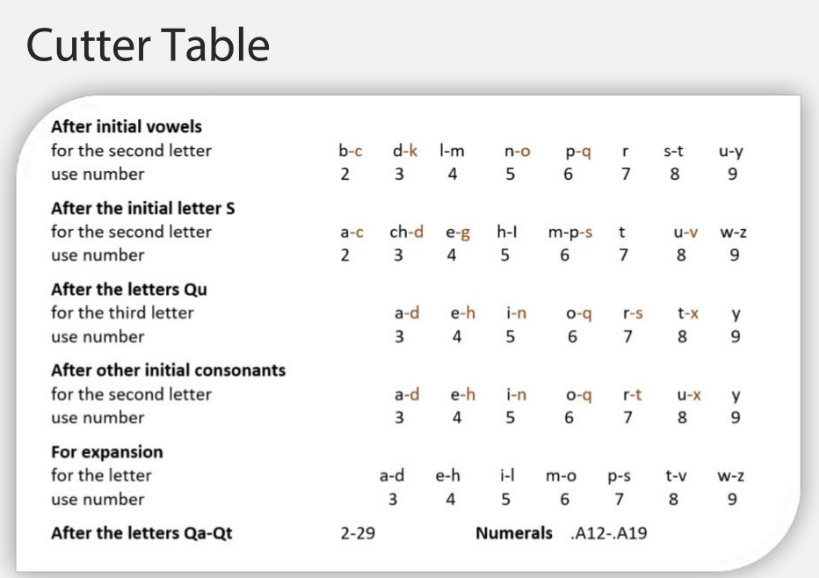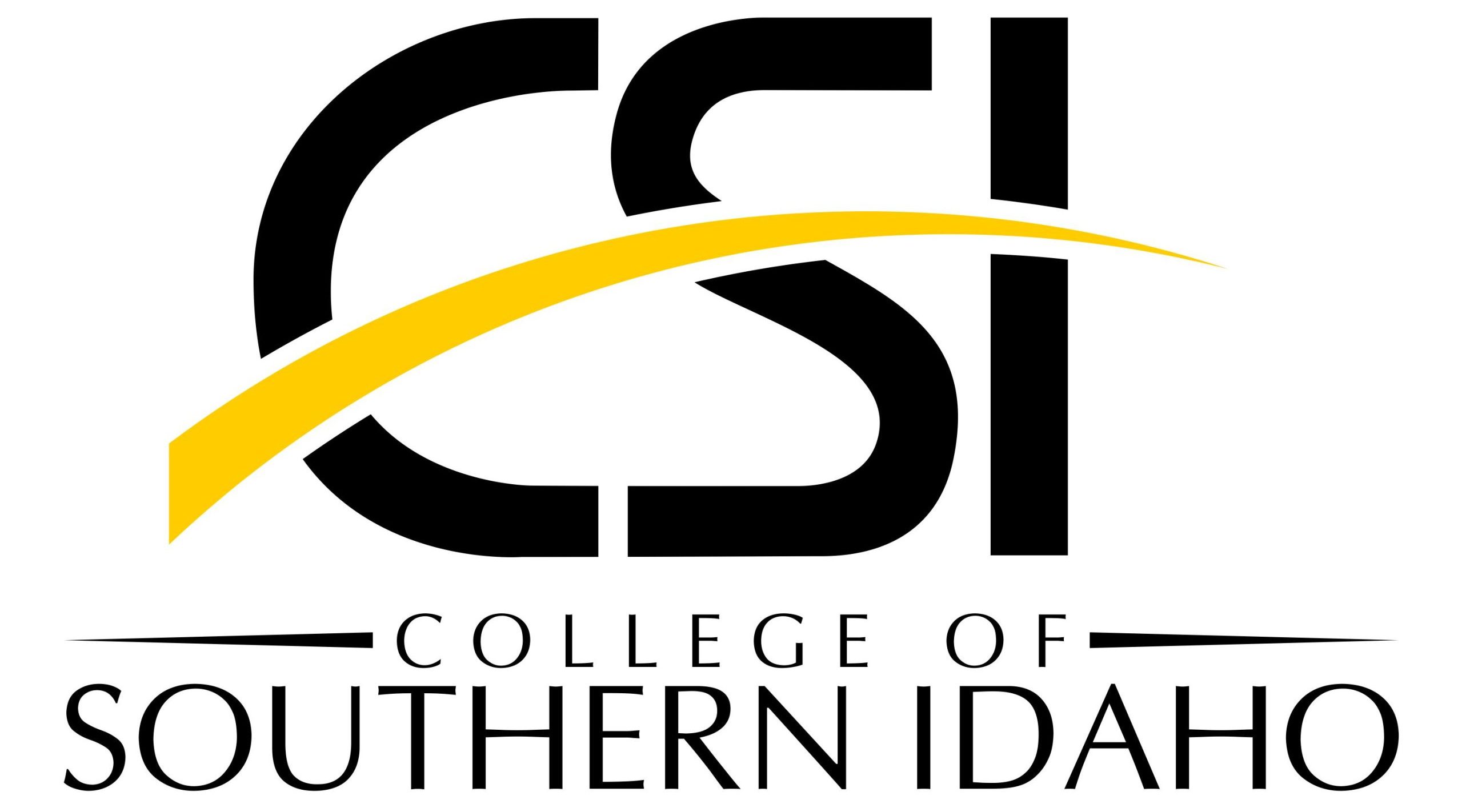9 Creating Cutters using the Library of Congress Classification System
The last LCC chapter examined the essentials of the LCC system. Now, we will put that to work and create an LCC number for a book. Most of this effort will be put toward creating Cutter numbers.
In the Library of Congress classification system, The Foundation trilogy has the call number PS3551.S5 A6 1982. This call number falls within the subclass PS, which includes all American literature. The number range after the subclass designation is 3500-3549. This number range consists of all American literature created between 1900 to 1960.
While the Cutter number is A6, another Cutter number, and perhaps the most thorough one, is A85668. The A6 Cutter number is not an author number but a “type of work” Cutter number generated for fiction. A6 states that the item in question is a selected work. The year 1982 is the year that the omnibus edition was published.
This is the guide table for the creation of LCC Cutter numbers:[1]
| 1. After initial vowel | ||||||||
|---|---|---|---|---|---|---|---|---|
| for the second letter:
use number: |
b
2 |
d
3 |
l-m
4 |
n
5 |
p
6 |
r
7 |
s-t
8 |
u-y
9 |
| 2. After initial letter S | ||||||||
| for the second letter:
use number: |
a
2 |
ch
3 |
e
4 |
h-i
5 |
m-p
6 |
t
7 |
u
8 |
w-z
9 |
| 3. After initial letters Qu | ||||||||
| for the third letter:
use number: |
a
3 |
e
4 |
i
5 |
o
6 |
r
7 |
t
8 |
y
9 |
|
| For initial letters Qa-Qt, use 2-29 | ||||||||
| 4. After other initial consonants | ||||||||
| for the second letter:
use number: |
a
3 |
e
4 |
i
5 |
o
6 |
r
7 |
u
8 |
y
9 |
|
| 5. For expansion | ||||||||
| for the letter:
use number: |
a-d
3 |
e-h
4 |
i-l
5 |
m-o
6 |
p-s
7 |
t-v
8 |
w-z
9 |
|
If you are creating a Cutter number based on a title that begins with numbers, use .A12-.A29 as your Cutter number, using .A12 for extremely low points of the number range in your holdings and .A29 as the high point.
Remember that if a letter comes up that is not in the table for some reason (for example, if you are making a Cutter for the surname Thomasin, the letter “h” will not appear in the table). In this instance, use the number for the letter in the table that most immediately precedes it. Below is an edited version of the table along these lines.

Sometimes, in the case of authors especially, the cutter number refers to a name. According to the Classification Schedule, in some instances the letter of the first cutter number is the second letter of the author’s last name. The numbers following it are generated by the table above. For example, the “S5” in the Cutter number above is a Cutter number that refers to “s-i” from the last name “Asimov.”
Occasionally, you will need to make a Cutter number for the book or author that is not from the Cutter Table. In fact, you should create Cutter numbers primarily based on availability of the Cutter. The number directed by the table may already be taken for one reason or another. The Cutter Table should be used only if the appropriate Table number has not been taken by another item or author in the catalog. The general rule is to avoid 0s, 1s, or 2s in your Cutter number. You should ensure that Cutter numbers are as short as possible and fit within the alphabetic listings already in the library. For example, if the Cutter Number for Strong is .S77 but there is already another author with Strong as a surname whose first name comes before the new author’s in the alphabet, the Cutter number might need to be .S78 or .S773 or .S774.
Author Cutter numbers are the second, and most common, cutter numbers. However, there are also topical cutter numbers. For instance, the cutter number for Acorns is A3. Bananas, on the other hand, are B3. If you cannot find a Cutter number, fit the number alphabetically between the other entries in the “A-Z” list according to the rules for author surnames in the paragraph above.
When creating Cutter numbers for works by corporate entities or societies, the same Cutter number should be used for all works. Years or work numbers (lowercase letters) should differentiate between parts of monographs and discrete resources.
When assigning a Cutter number based on a corporate or government-associated group, the broadest corporate name should be used to assign a Cutter number. For example, if the American Historical Association has a Cutter number of .A46, then the Utah chapter of that organization should also have a Cutter number of .A46. Jurisdiction areas for corporations, government-associated institutions, and government departments should be ignored unless they are in the title or the first subheading.
If departments of a government are responsible for a specific work, the name of the parent department should be used, not any of its subgroups. In a comparable fashion, only the first subheading of a government department or group that has multiple subheadings should be considered.
Editions and abridgments should have similar but distinct Cutter numbers. Translations of works should have the same Cutter number as the original work or edition, being distinguished by a year and/or another Cutter number.
When corporations are the subject of a work, that work should be assigned the same Cutter number as a work that was created by that corporation. This Cutter number should be accompanied by another Cutter number that specifies the author or the date. This will ensure that those who are paying attention to cataloging rules will know that the work is about a corporation rather than by a corporation.
The same thing is true if a person is the subject of a biography. If they are an expert on a particular subject and have created a work on that subject, a biography about them should be entered on that subject, with the same subject Cutter number. The person’s cutter number may be recorded but can also be replaced by that of the author of the biography.
Apply your Knowledge
Now let’s try to make some LCC Cutter numbers. Check out the LCC Outline, including PDFs that go into more detail than the list on the other LCC page. This will give you the first block of letters and numbers that should be included in the call number. Remember to be as specific as you reasonably can to give a unique cutter number to the item.
In order to create an LOC Cutter number, use the table above or go to https://calculate.alptown.com/. Use the website by clicking on “LC Cutter” (which should be the default selection anyhow) and typing in at least the first three letters of the last name of the author. In either case, be prepared to defend your answer using the table.
General Principles of Classification have been prepared by the Library of Congress to guide catalogers in assigning books to particular subjects in the LCC. For example, this document reviews whether or not to emphasize the geographic setting of the work over its subject. Catalogers are encouraged once again to be as specific as possible.
Expansion upon these principles is often necessary to be able to classify works and create call numbers for specific items. Catalogers often also need to be able to view entire classes as a group and organize them. To enable catalogers to handle the minutiae of their daily tasks, the Library of Congress created an Online Training on the LCC.
Sometimes it is best to learn about these things through reading, and obviously it is impossible to give guidance on every situation in a textbook such as this, even though it is online. The Library of Congress Classification and Shelflisting Manual will help you with any questions regarding best practices and tricky cataloging decisions.
- Library of Congress. Cutter Table. Retrieved on December 6, 2022 from https://www.loc.gov/aba/pcc/053/table.html. ↵


Feedback/Errata